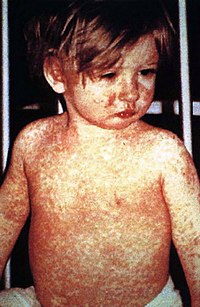
Photo from wikipedia
To the Editor: We read with great interest the report by Iannone et al and would like to make a contribution to the discussion in the light of the recent… Click to show full abstract
To the Editor: We read with great interest the report by Iannone et al and would like to make a contribution to the discussion in the light of the recent findings in the field. Hidradenitis suppurativa (HS) itself is a disease with prominent autoinflammatory features. HS may also be a component of systemic autoinflammatory syndromes like pyoderma gangrenosum, acne, pyogenic arthritis, and suppurative hidradenitis (PAPASH) and pyoderma gangrenosum, acne, and suppurative hidradenitis (PASH), which are associated with mutations in proline-serinethreonine phosphatase interacting protein 1 gene (PSTPIP1). In patients with familial Mediterranean fever (FMF), the most common hereditary autoinflammatory disease, HS may present with a severe phenotype and overlapping PAPASH-like features. Moreover, the rates of FMF and heterozygous Mediterranean fever gene (MEFV) mutations were found to be increased in a cohort of patients with severe HS compared with the normal population. Notably, in 2 of the 4 patients with HS and pyoderma gangrenosum, double pathogenic mutations in MEFV without clinical FMF and promoter elongation in PSTPIP1 coexisted. A molecular link between FMF and PASH/PAPASH was proposed in patients with complex HS, especially when accompanied by pyoderma gangrenosum, as the products of MEFV and PSTPIP1 interact with each other. MEFV mutations were also found to be more frequent than those in the normal population, associated with disease severity, and of prognostic importance in many inflammatory diseases other than HS, such as rheumatoid arthritis, spondyloarthropathies, vasculitis, Behçet syndrome, inflammatory bowel diseases, multiple sclerosis, and glomerulonephritis. So, it is not surprising to encounter MEFV mutations in patients with chronic inflammatory diseases and secondary amyloidosis, especially in geographic regions and races with a high frequency of FMF. MEFV mutations without clinical FMFmay occasionally be found in whites, in
Journal Title: JAAD Case Reports
Year Published: 2019
Link to full text (if available)
Share on Social Media: Sign Up to like & get
recommendations!